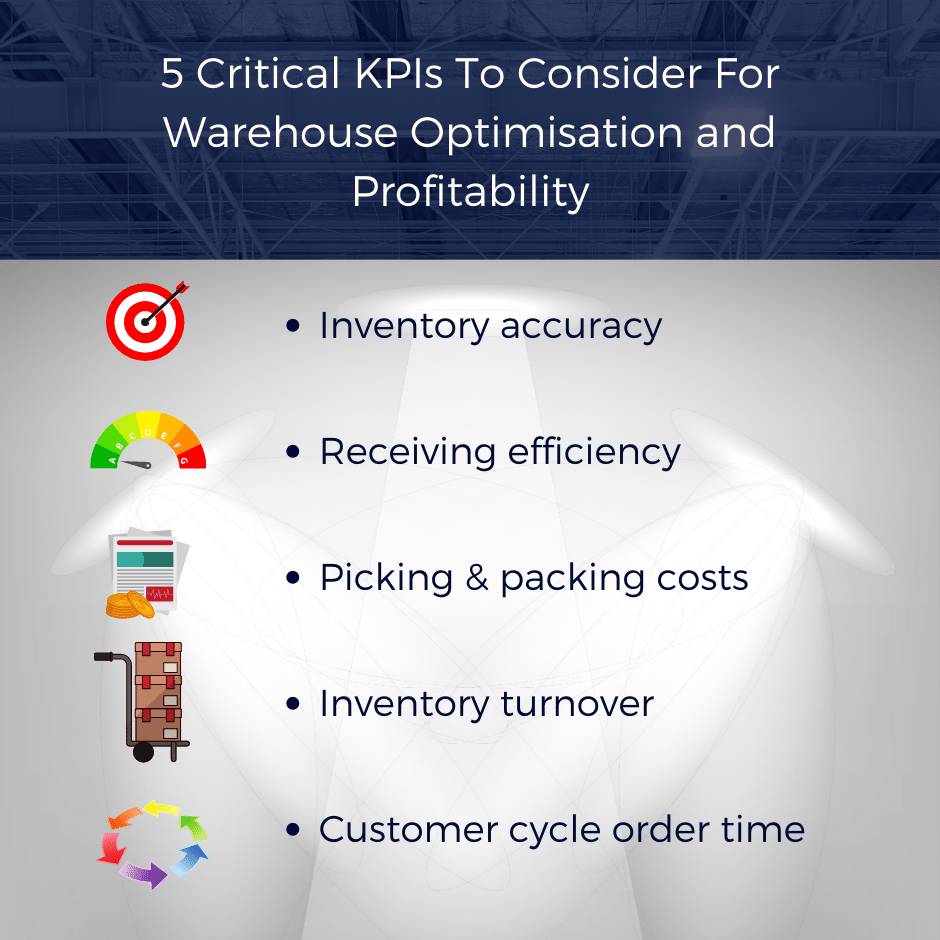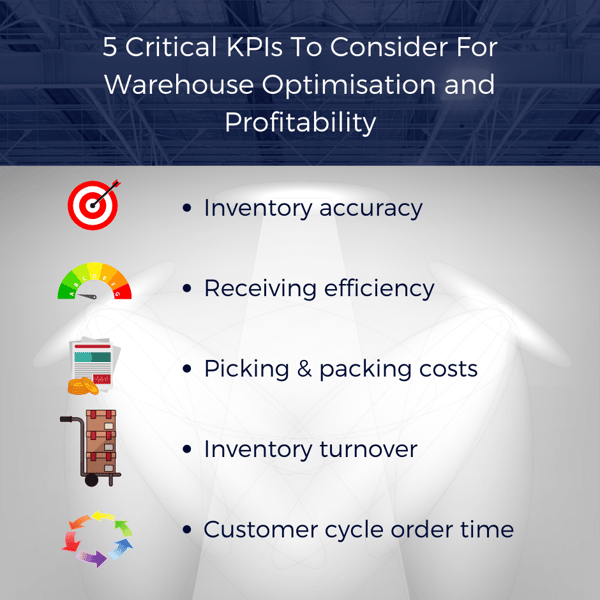5 Guidelines To Warehouse Optimisation & Performance Management


An organised warehouse is an efficient warehouse, with excellent management guiding KPIs for maximum profitability. Therefore, your warehouse optimisation can make or break your business’s bottom line. What should you be looking at, and what can help you to accomplish this?
5 Critical KPIs To Consider For Warehouse Optimisation and Profitability

All warehouse managers strive for efficiency to keep costs low and revenue high. Leveraging these critical KPIs for warehouses – inventory accuracy, efficiency of receiving, picking and packing cost, inventory turnover, and customer cycle order time – will help warehouse managers run a cost-efficient, streamlined, and effective warehouse that keeps inventory moving smoothly and customers satisfied.
Why is it important to optimise your warehouse?
Efficiency is key to every business: if every department of your company is well organised, overall productivity will increase significantly. When streamlining warehouse management, the foundation you build determines how well your operation will run, and ensure future success and therefore profitability. By thinking about warehouse optimisation from the beginning you will set high-efficiency standards performance and capabilities.
Warehouse management = Warehouse performance
Warehouse management is essential to any logistics system, which is an essential role in supply chain management with some warehousing process elements playing a significant role throughout supply chain system efficiency.
Organising and optimising your warehouse has significant financial benefits, and businesses who don’t lose large amounts of money due to out-of-stocks, returns, and human error, all which could be avoided easily.
Warehouse optimisation is all about continually improving efficiency. It requires careful planning and execution. These are some steps you can take to optimise your warehouse in order to grow your business.
1. Warehouse Organisation
The first rule for optimising your warehouse is to get every item organised. A good starting point is to optimise the layout of your warehouse and use your space to maximum capacity.
When everything is organised it is easier to complete individual jobs quicker, and therefore more jobs in a day.
Labour is maximised as employees work smarter, not harder, and you also save on overhead costs by not expanding warehousing unnecessarily.
2. Efficient Warehouse Processes
As a business owner or warehouse manager, the main goal is to ensure that the right product gets to the right place at the right time. In order to achieve this, your entire warehouse operation from receiving, to picking, to shipping, to data collection needs to be optimised constantly for improved results.
There are two ways for receiving products: manual and automated. In the manual checking process, an employee looks over a shipping invoice and visually checks that everything listed has arrived and has the right quantity. This method is cheaper but it massively increases the chance of human error. To combat that a double-check facility is required, which in turn increases expenses.
By automating this process with warehouse management software, you can reduce errors, saving time and money, simply scanning product barcodes and uploading all the information to your server for visibility throughout.
3. Warehouse Data Collection
Data collection is essential to allow warehouse managers to see what the workers are doing well, versus what areas need improvement. Having access to real time insights will keep managers informed about all the processes so they can take informed decisions.
Today, mobile devices with barcode scanners are a very reliable solution to collect data about every process in the warehouse.
Ultimately, data integrity is the difference between being able to keep promises to end customers, or running around trying to find items you were sure you had in stock.
4. Warehouse Automation
Automation refers to identifying repetitive tasks that are process-oriented, time-consuming, or error-prone, and finding ways to automate them. It involves the use of software and tools to coordinate various departments in a warehouse, while uploading and organising data into a single platform.
One of the main benefits of warehouse automation is speed, but warehouse automation doesn’t just speed up product retrieval; it also speeds up order fulfillment, and fulfilled customers are repeat customers.
5. Warehouse Tools and Software
To keep a competitive edge in any industry you have to be able to adapt and meet the expectations of your consumers. In an era of digital technology, you don’t want to fall behind, so you need to embrace advances for smart warehouses, and stay digitally relevant.
Barcode scanners, minicomputers, tablets, and radio-frequency identification (RFID) are some of the better known warehouse data collection tools.
Your final goal must be to automate your workflow, so you need to use the right tools appropriately.
Taking initiative for warehouse efficiency, accuracy, and profitability:
Successfully managing a warehouse means taking the initiative to increase the profits of your business and work smarter, not harder.
As the gatekeepers between businesses and consumers, warehouses and their management contributes to companies’ development and growth by taking care of products and consumers.
This means that warehouse optimisation contributes largely to the success - or failure - of a company. By optimising workflow processes and using the correct tools and software, you will minimise costs and optimise profits in no time, leading to not only a future-proof company but one with long term returns on its software investments.
To get started on your WMS journey, give us a call to discuss your requirements.
Alternatively, download the WMS Optimisation Checklist for a clearer picture of how to get your warehouse running efficiently and profitably.
TAGS
- WMS (51)
- Warehouse Best Practice (46)
- Implementing a WMS (29)
- Managing your warehouse (19)
- Omni Channel (18)
- eCommerce (18)
- Blog (16)
- Supply Chain Best Practice (16)
- Customer Journey (9)
- Mid-Level (8)
- Warehouse optimisation (7)
- General Tips (5)
- Industry General (5)
- Information (5)
- Trends (5)
- managing your Supply Chain (5)
- saudi arabia (5)
- Press Release (4)
- smart warehouse (4)
- 3PL (3)
- News (3)
- ERP (2)
- Entry-level (2)
- ROI (2)
- Case Study (1)
- OMS (1)
- Picking (1)
- Solution-Specific (1)
- Transport Management System (1)
Take A Look At The Results Of A Successful WMS Implementation.
See how Tarsus Distribution, in collaboration with SCJ boost overall efficiency by 60%




